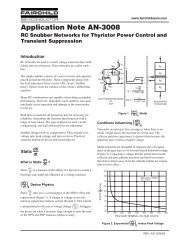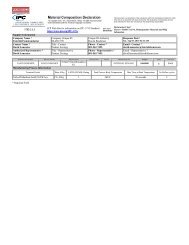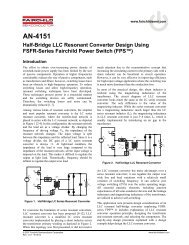AN-6094 Design Guideline for Flyback Charger Using FAN302HL/UL
AN-6094 Design Guideline for Flyback Charger Using FAN302HL/UL
AN-6094 Design Guideline for Flyback Charger Using FAN302HL/UL
You also want an ePaper? Increase the reach of your titles
YUMPU automatically turns print PDFs into web optimized ePapers that Google loves.
<strong>AN</strong>-<strong>6094</strong><br />
Once the tOFF is determined at operating point B, the<br />
MOSFET conduction time is obtained as:<br />
1/ fS − tOFF@B<br />
tON<br />
@ B =<br />
min<br />
N V S DL@ B<br />
(1 + ⋅ )<br />
(24)<br />
N P VO@B + VF<br />
Then, the trans<strong>for</strong>mer primary-side inductance can be<br />
calculated as:<br />
min 2<br />
( VDL@B⋅tON@B) Lm = ⋅ fS<br />
(25)<br />
2PIN.<br />
T @B<br />
Once the trans<strong>for</strong>mer primary-side inductance is<br />
determined, DCM operation at operating point C should<br />
be checked. To prevent CCM operation, F<strong>AN</strong>302<br />
decreases the switching frequency as the output voltage<br />
drops, as illustrated in Figure 13. The switching frequency<br />
at the minimum output voltage is obtained as:<br />
Δf<br />
V + V<br />
f f (2.15 V<br />
)<br />
S<br />
O@ C F. SH<br />
S@C = S − − SH@A⋅ N<br />
Δ VSH VO+ VF.<br />
SH<br />
(26)<br />
where ΔfS / ΔVSH is 64 kHz / V <strong>for</strong> <strong>UL</strong> version and<br />
38 kHz / V <strong>for</strong> HL version, and VF.SH is the rectifier<br />
diode <strong>for</strong>ward voltage drop at the VS sampling instant<br />
(85% of diode conduction time).<br />
Then, the MOSFET conduction time at operating point C<br />
is given as:<br />
2P<br />
L<br />
= (27)<br />
1 IN. T@Cm ON @C min<br />
VDL@CfS@C t<br />
The non-conduction time at operating point C is given as:<br />
V<br />
(1 )<br />
min<br />
1<br />
NS<br />
DL@ C<br />
OFF @C= − ON @C+<br />
⋅<br />
fS@C NP VO@C + VF<br />
t t<br />
(28)<br />
The non-conduction time should be larger than 15% of<br />
switching period, considering the trans<strong>for</strong>mer variation<br />
and frequency hopping.<br />
Figure 12. Variation of tON, tD, and tOFF<br />
Figure 13. Frequency Reduction in CC Mode<br />
Once the trans<strong>for</strong>mer primary-side inductance is obtained,<br />
the maximum peak drain current can be calculated at the<br />
nominal output condition (operating point A) as:<br />
2PINT . @A<br />
PK<br />
IDS<br />
=<br />
(29)<br />
Lm⋅fS The minimum number of turns <strong>for</strong> the trans<strong>for</strong>mer<br />
primary side to avoid the core saturation is given by:<br />
© 2012 Fairchild Semiconductor Corporation www.fairchildsemi.com<br />
Rev. 1.0.0 • 9/27/12 8<br />
N<br />
min<br />
P<br />
PK<br />
LmIDS = (30)<br />
B A<br />
sat e<br />
where AE is the cross-sectional area of the core in m 2<br />
and Bsat is the saturation flux density in Tesla. Figure 14<br />
shows the typical characteristics of a ferrite core from<br />
TDK (PC40). Since the saturation flux density (Bsat)<br />
decreases as the temperature rises, the high temperature<br />
characteristics should be considered, especially <strong>for</strong><br />
charger application in an enclosed case. If there is no<br />
reference data, use Bsat=0.25~0.3T. With the turns ratio<br />
obtained in STEP-3, determine the proper integer <strong>for</strong> Ns<br />
min<br />
such that the resulting NP is larger than NP obtained<br />
from Equation (30).<br />
Figure 14. Typical B-H Curves of Ferrite Core<br />
(TDK/PC40)








